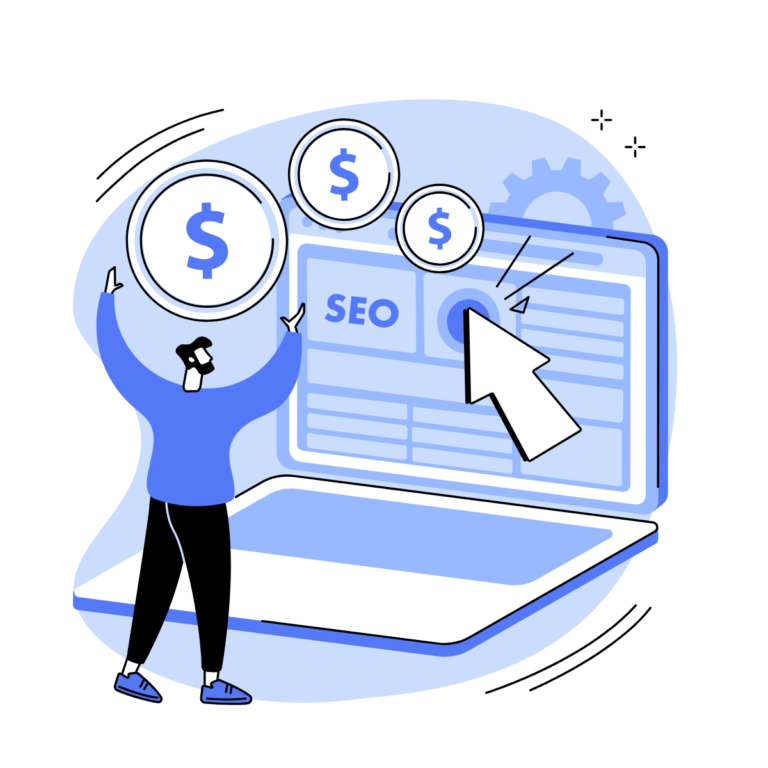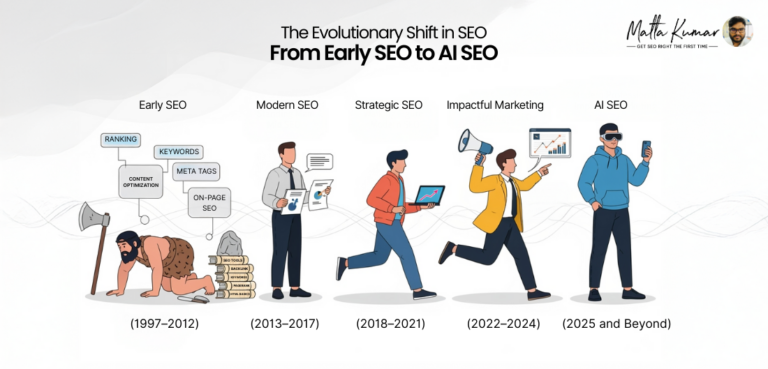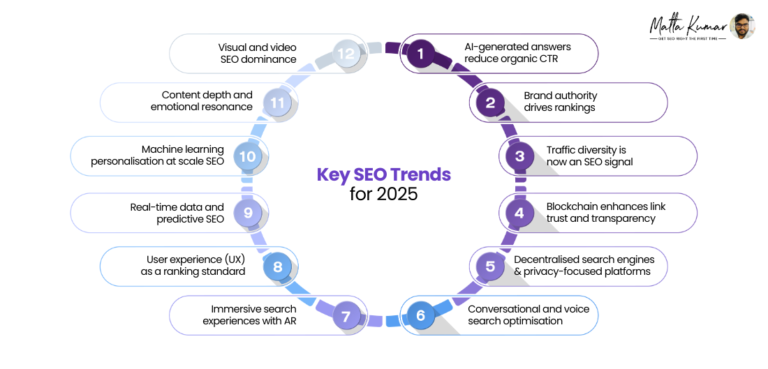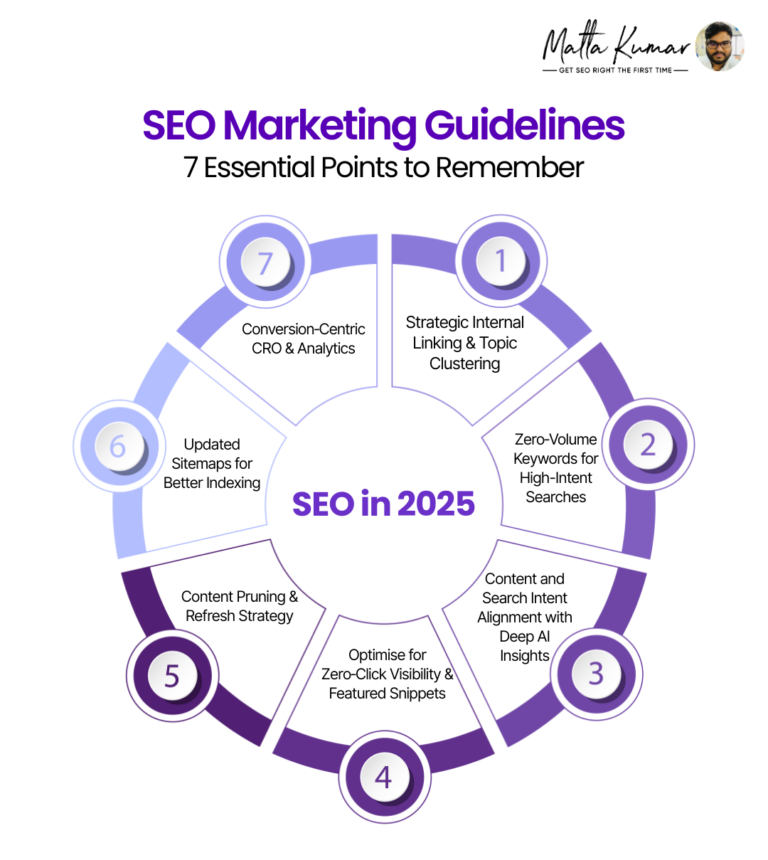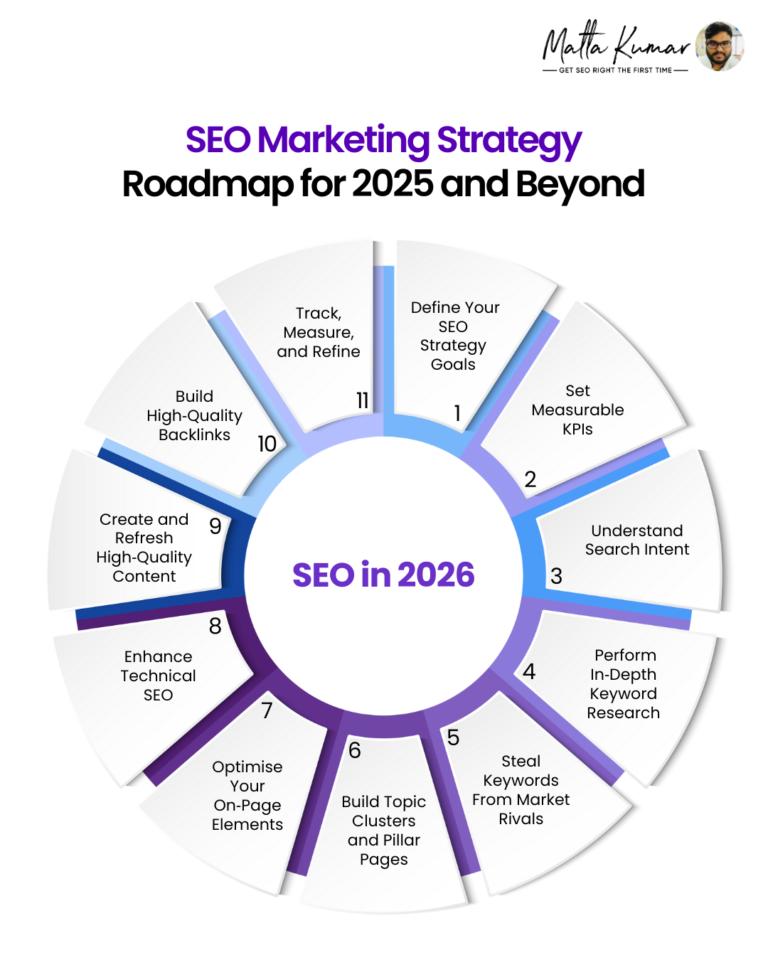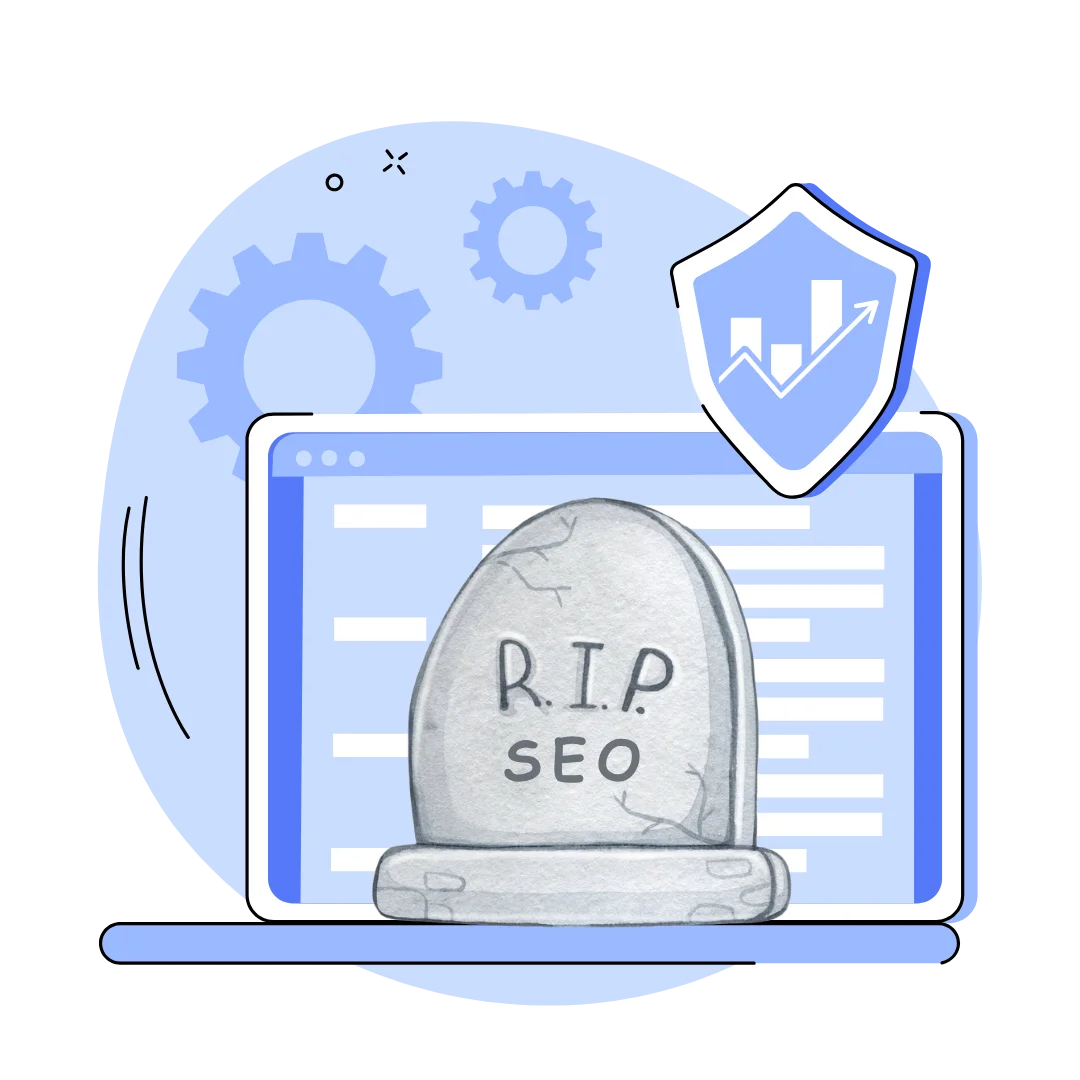TL; DR
Getting traffic is only half the game. However, real SEO wins happen when converting it into measurable results. In this blog, we unpack new SEO strategies for 2025 that go beyond rankings. Learn how to align SEO with business outcomes, improve conversion funnels, and build a brand presence that fuels sustained growth.
The search landscape is in a state of flux. The fluid nature of Google and other search platforms has ruffled up SEO marketing strategy, as we speak, courtesy of cutting-edge generative AI models. It is no longer about winning the #1 position in Google. So website clicks won’t move your revenue needle because your target audiences find answers through AI Overviews and ChatGPT summaries, YouTube guides, or Reddit forum reviews without dropping by your website. Approximately 58.5% of Google searches end with zero clicks.
Hence, quit following the footsteps of industry experts or doing it by the old book. Instead, embracing the diverse concepts built around AI-powered algorithms, testing, and learning from collective insights is a new way forward.
This guide breaks down the most effective SEO strategies to help you achieve the same feat. Before diving right into the new marketing model, let’s take a step back and revisit the evolutionary timeline for SEO.
The archaic approach to scaling online visibility and rankings for more organic traffic has been archived. The proverbial truth is not explicitly stated, but it’s there. Search engine optimisation (SEO) has evolved alongside search platforms, and here’s the evolutionary timeline for a quick sneak into its history.
Early SEO (1997–2012)
SEO began in the late 1990s with meta‑tag manipulation, keyword stuffing, and directory submissions, a precursor to modern optimisation techniques.
Modern SEO (2013–2017)
By 2013, SEO had already matured to emphasise quality backlinks, user‑centric content, and algorithm‑aware practices driven by Google’s PageRank and Panda updates.
Strategic SEO (2018–2021)
Strategic SEO emerged with integrated content clusters, technical optimisation, and user intent mapping to support long‑term growth.
Impactful Marketing (2022–2024)
SEO evolved into impactful marketing that merged brand engagement, performance metrics, and cross‑channel amplification.
Immersive Experience with AI SEO (2025 and beyond)
Impactful marketing is not entirely dead, but SEO has now stepped beyond the ‘website ranking for keywords’ threshold with generative AI. In the coming days, hyper-personalisation and immersive experiences are something to look forward to. Now, the focus has shifted to AI‑sourced content and conversational discovery.
Key Takeaway: Year 2025 is witnessing the dawn of a new evolution with generative AI models. What happens next is more involvement of cutting-edge technologies that will change the power play of SEOs.
Key SEO Trends Impacting Conversions in 2025 and Beyond!
In 2025, the SEO landscape is more impactful, only if you know the right tricks and technologies. In order to thrive in the continuous seismic shifts, businesses must move beyond basic optimisation and align with more profound shifts in search technology, user expectations, and algorithmic priorities. The most impactful SEO trends in 2025 and beyond influence everything from visibility to conversion.
1. AI-generated answers reduce organic CTR
With AI Overviews and zero-click search becoming the new norm, search engines now satisfy more queries without requiring a user to click through. This shift has resulted in a drop in organic click-through rates (CTR), particularly for top-of-funnel informational content. Google’s RankBrain and MUM are not just surfacing summaries; they’re interpreting context and delivering instant answers.
2. Brand authority drives rankings
Google’s focus on E.E.A.T. (Experience, Expertise, Authoritativeness, Trustworthiness) has intensified. Though not a direct ranking signal, sites demonstrating real-world authority, backed by named authors, external citations, brand mentions, and multi-platform visibility, enjoy substantial visibility boosts.
3. Traffic diversity is now an SEO signal
Search engines are also assessing how users arrive at your site. Pages that receive traffic from diverse sources (search, social, direct, email, and referral) tend to rank higher and convert better. This is because diverse traffic indicates relevance, popularity, and brand health.
4. Blockchain enhances link trust and transparency
Blockchain is emerging as a tool for verifying backlinks. It can record link-building transactions on an immutable ledger, helping search engines distinguish between legitimate and manipulative links. This transparency may shape future link authority signals, especially in a post-E.E.A.T. era.
5. Decentralised search engines & privacy-focused platforms
Rising privacy concerns enabled decentralised search engines powered by blockchain to gain attention. These platforms offer user-owned data models and limit ad monetisation. This will change how SEO strategies must be structured, especially for privacy-savvy audiences.
6. Conversational and voice search optimisation
Content must match natural, question-based queries as users increasingly rely on voice assistants like Alexa and Google Assistant. Structuring answers in a conversational tone, using long-tail and intent-rich phrases, is vital for capturing voice search visibility.
7. Immersive search experiences with AR
Augmented Reality (AR) is poised to influence how users engage with search results. Imagine trying on products virtually from within the SERPs. Brands incorporating AR previews, 3D product models, or interactive elements stand to gain an edge in rankings and conversions.
8. User experience (UX) as a ranking standard
Google’s Core Web Vitals are now essential. But UX in 2025 includes intuitive design, accessibility, and engagement loops. Sites that delight users beyond the first click are rewarded with higher rankings and longer dwell times.
9. Real-time data and predictive SEO
Thanks to AI, predictive analytics tools are helping brands identify future keyword trends and seasonal behaviours before they peak. This enables proactive optimisation and content planning that aligns with emerging interests.
10. Machine learning personalisation at scale
Search engines now adjust results based on real-time engagement metrics like bounce rate, time-on-page, and return visits. To compete, websites must personalise user journeys, offering dynamic content, tailored recommendations, and behaviour-driven UX experiences.
11. Content depth and emotional resonance
In 2025, surface-level content won’t cut it. Google’s NLP capabilities (e.g., BERT, MUM) favor emotionally engaging and context-rich storytelling. Brands must create content that doesn’t just inform but connects deeply, especially for B2C and lifestyle sectors.
12. Visual and video SEO dominance
Platforms like Google Lens, YouTube Shorts, and TikTok influence what appears in SERPs. Visual search and video carousels are pulling traffic away from text-heavy blogs. Future SEO strategy needs video schema markup, image alt optimisation, and thumbnail A/B testing.
Bonus Tip: AI writing tools are now widely used, but the winning formula is AI + Human. Automated content must be reviewed for authenticity, tone, and originality for a winning SEO marketing strategy that maintains brand trust and E.E.A.T. standards.
SEO Marketing Guidelines: 7 Essential Points to Remember
James Dooley said, “If you do not innovate, you will evaporate.”
His words articulate the search reality of 2025, dominated by Google’s AI Overviews and LLMs (ChatGPT, Perplexity, and others). The seismic shift has compelled professionals across the spectrum to question their approach to online marketing. Algorithm updates from the recent generative AI implementation have pulled down website traffic from its #1 metric position. Attracting site visitors is not obsolete, but it is insufficient to keep your business afloat, let alone boost its growth.
The modern SEO marketing strategy defines business success by its ability to turn traffic into a continuous revenue stream.
The updated SEO guideline highlights methods for aligning visibility with real business results. Let’s dive right in:
1. Strategic Internal Linking & Topic Clustering
Internal linking is a key part of an SEO optimisation strategy. Anchored links and topic clusters help distribute authority, improve crawlability, and boost user engagement across pages. This improves rankings and positions you to convert website visitors into customers.
2. Zero‑Volume Keywords for High-Intent Searches
Low- or zero-search-volume long-tail queries often reveal users who are deep in the buying journey. Targeting such terms can drive conversions even with modest traffic. These SEO strategies help you reach the right audience at the right moment.
3. Content and Search Intent Alignment with Deep AI Insights
Modern SEO strategies lean on AI-driven content tools and data from Google Search Console. It’s no longer about just keyword density. Instead, it’s about serving user needs with targeted, actionable content that ranks and converts.
4. Optimise for Zero‑Click Visibility & Featured Snippets
Zero-click searches (featured snippets, People Also Ask) are prime real estate. By structuring content to answer direct user questions succinctly, you can secure visibility even without a click, thus boosting brand recognition and later converting prospects.
5. Content Pruning & Refresh Strategy
Outdated or underperforming content can dilute domain authority. Strategic pruning or updating and anchoring it with new internal links improves overall SEO strength and channel efficiency. This ensures focus remains on high-converting content.
6. Updated Sitemaps for Better Indexing
You may have the best content, but if Google can’t see it, it won’t matter. Regularly submitting XML sitemaps, especially after content updates or pruning, ensures that search engines swiftly crawl and index your most important pages. Think of this as sending a map directly to Google’s crawlers.
7. Conversion‑Centric CRO & Analytics
Your SEO strategy must be outcome-focused. Blend SEO with CRO tactics, like A/B testing compelling headlines and optimised CTAs, and use tools like GA4 and Search Console to track how traffic translates to revenue.
Key Takeaway: This guideline transforms SEO from a traffic‑chasing tactic into a revenue‑boosting discipline. You’re not just optimising for clicks, you’re building a functionally integrated revenue-driven SEO strategy that aligns with business objectives, real user behaviour, and evolving search trends.
How to Build an Effective SEO Marketing Strategy - 11 Step Process
As mentioned earlier, the rules of SEO have shifted, and yesterday’s playbook won’t garner enough clicks for your website in 2026. Here’s a fresh approach to building your SEO marketing strategy that is both technology-driven and result-focused, promising a quick ranking and better conversion potential.
Step 1: Define Your SEO Strategy Goals
- Is it higher rankings, more qualified leads, or stronger brand visibility?
Step 2: Set Measurable KPIs
- Is it organic traffic growth, engagement metrics, or conversions?
Step 3: Understand Search Intent
- Segment keywords into informational, navigational, and transactional.
- Create content that delivers the exact solutions your audience seeks.
Step 4: Perform In‑Depth Keyword Research
- Use keyword tools to uncover high-volume and long‑tail terms.
- Target “zero‑volume” keywords that match niche queries with strong intent.
Step 5: Steal Keywords From Market Rivals
- Run a keyword gap analysis to uncover opportunities they’ve already validated.
- Check their highest‑traffic pages.
- Prioritise commercial‑intent content such as:
- Product/service pages
- Comparison and pricing pages
- “Best X for Y” listicles
- How‑to guides with buying angles
- Export their ranking keywords and understand the entire keyword cluster.
Pro-Tip: Build 3–6 months of high‑impact content opportunities using competitor insights.
Step 6: Build Topic Clusters and Pillar Pages
- Create authoritative pillar content around broad themes.
- Link supporting posts (guides, reviews, FAQs) back to the main page.
Step 7: Optimise Your On‑Page Elements
- Use compelling meta titles and descriptions.
- Structure content with H1/H2/H3 tags aligned to search intent.
- Implement schema markup for snippets and FAQs.
Step 8: Enhance Technical SEO
- Optimise site speed, mobile usability, and Core Web Vitals.
- Submit XML sitemaps and fix crawl/indexing issues in Google Search Console.
Step 9: Create and Refresh High‑Quality Content
- Regularly update older content with new stats, visuals, and internal links.
- To build credibility, focus on E-E‑A‑T (Experience, Expertise, Authoritativeness, Trustworthiness).
Step 10: Build High‑Quality Backlinks
- Earn links from relevant, authoritative websites.
- Use guest posting, digital PR, and link‑worthy content assets.
Step 11: Track, Measure, and Refine
- Monitor keyword rankings, engagement metrics, and user behaviour with GA4 and Search Console.
- Use the data to refine content and update your SEO optimisation strategies continuously.
Key Takeaway: A powerful SEO marketing strategy in 2025 blends competitor insights, technical precision, and intent‑driven content to achieve sustainable rankings and brand visibility.
James Dooley said, “If you do not innovate, you will evaporate.”
His words articulate the search reality of 2025, dominated by Google’s AI Overviews and LLMs (ChatGPT, Perplexity, and others). The seismic shift has compelled professionals across the spectrum to question their approach to online marketing. Algorithm updates from the recent generative AI implementation have pulled down website traffic from its #1 metric position. Attracting site visitors is not obsolete, but it is insufficient to keep your business afloat, let alone boost its growth.
The modern SEO marketing strategy defines business success by its ability to turn traffic into a continuous revenue stream.
The updated SEO guideline highlights methods for aligning visibility with real business results. Let’s dive right in:
Conclusion
Success in SEO today requires more than traffic growth. It demands alignment between user intent, content experience, and business objectives. The best habits now focus on smart integration of SEO strategy that serves broader marketing goals, meaning, every search presence must drive revenue growth and brand visibility.
When you turn traffic into conversions and then into repeat revenue, your SEO becomes an actual growth engine. In 2025 and beyond, the winning formula for your SEO marketing strategy must be: Think revenue; Build for intent; Optimise for outcomes.
Key Takeaway: Focus on visibility, trust, and measurable outcomes.
FAQs
1. Why is traffic no longer the main SEO metric in 2025?
Because rankings and clicks don’t guarantee growth, businesses now measure success by brand visibility and revenue outcomes.
2. How does a modern SEO marketing strategy drive revenue?
By blending content, CRO, and data insights to guide users from discovery to conversion.
3. What are the most important SEO optimisation strategies today?
Topical authority, Answer Engine Optimisation, programmatic SEO, and funnel‑driven content creation.
4. How can I convert website visitors into customers more effectively?
Focus on mobile‑first design, strong CTAs, review integration, and remarketing funnels.
5. What’s the biggest change in SEO for 2025?
The shift from traffic metrics to a focus on visibility, trust, and revenue impact powered by AI and intent‑driven search.

